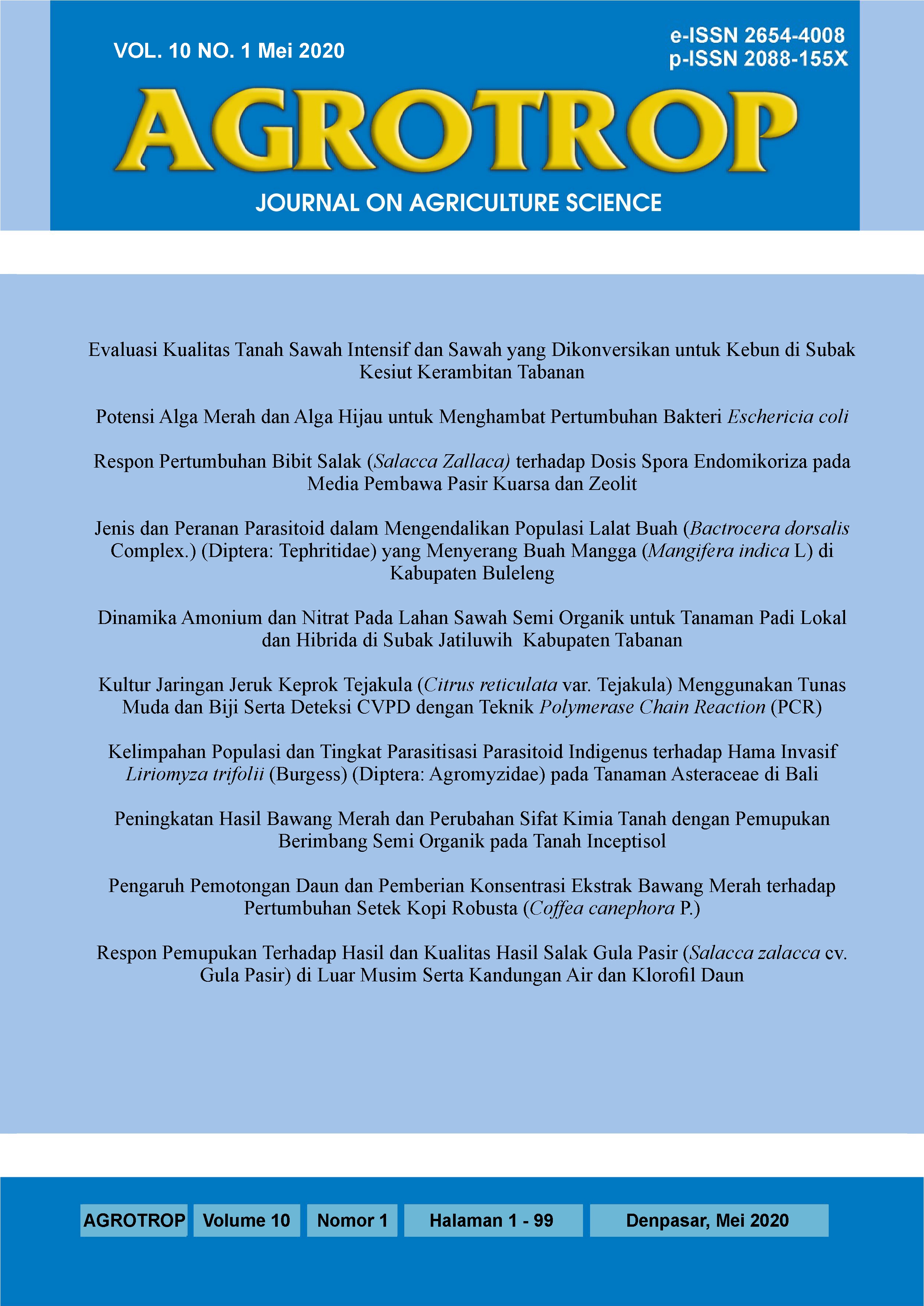Potensi Alga Merah dan Alga Hijau untuk Menghambat Pertumbuhan Bakteri Eschericia coli
Abstract
Potential of Red Algae and Green Algae to Inhibit Escherichia coli Bacteria Growth. The use of synthetic chemicals as a control for the growth of E. coli bacteria that causes of diarrhea children can cause adverse effects on health, so it needs natural control ingredients that do not cause impacts on human health. One natural controller to inhibit bacterial growth is by utilizing natural sources, including seaweed. The purpose of this study was to examine the potential of seaweed as an anti-bacterial agent of E. coli. The research used seaweed extract of Eucheuma spinosum, Euchuema cottonii, Gracilaria spp., and Caulerpa spp. The test parameters observed were the inhibition zone (mm) of each seaweed extract treatment using a ruler and measured the inhibition zone distance. The results showed that E.cottonii seaweed extract had the highest inhibitory ability with an inhibition zone diameter of 11.1 mm, including the moderately sensitive category, then Caulerpa spp. with a inhibition zone diameter of 10.0 mm, Gracilaria spp has the ability to inhibit E.coli bacteria with a inhibition zone diameter of 6.9 mm, including the insensitive category, and the lowest in seaweed E. spinosum with a inhibition zone diameter of 4.2 mm. including the insensitive category.
Downloads
References
Chalyyn, Pakidi dan Hidayat. 2017. Potensi dan Pemanfaatan Bahan aktif Alga Coklat sargassum sp. Octopus Jurnal Ilmu Perikanan. Vol 6 No 1
Cox,S.,Ghanam,N., Gupta,S. 2010. An assesment of the Antioxidant and Antimicrobial activity of six species of Edible Irish Seaweeds. International Food Research Journal 17: 205-220
Rajasulochana,P., P. Krishnamoorthy and R.Damotharan. 2013. An Investigation on the Antioxidants, Antifungal and Antibacterial of the Kappaphycus alvarezii.Research Journal of Pharmaceutical, Biological and Chemical Sciences. RJPBCS Volume 4 Issue 1
Sartika , R., Melki dan A I.S. Purwiyanto. 2013. Aktivitas Antibakteri Ekstrak Rumput Laut Eucheuma cottoni terhadap Bakteri Escherichia coli, Staphylococcus aureus, Vibrio cholera dan Salmonella typhosa. Maspari Journal, 2013, 5 (2), 98-103
Siregar, A.F., S. Agus dan P. Delianis. 2012a. Potensi Antijamur dan Antibakteri Ekstrak Rumput Laut terhadap Jamur A. flavus dan Bakteri Pseudomonas aeruginosa.http://ejournal- s1.undip.ac.id/index.php/jmr. Akses 11 April 2016.
Siregar, A.F., S. Agus dan P. Delianis. 2012b.
Potensi Anti Bakteri Ekstrak Rumput Laut Terhadap Bakteri Penyakit Kulit Pseudomonas aeruginosa, Staphylococcus epidermides, dan Micrococcus luteus. Journal of Marine Research . Volume 1 No 2. Hal 152-160.
Suryati, N., E.Bahar., Ilmiati. 2017. Uji efektivitas Ekstrak Aloevera Terhadap Pertumbuhan Escherichia coli secara in vitro. Jurnal Kesehatan Andalas 6(3)
Wiyanto, D.B. 2010. Uji Aktivitas Antibakteri Ekstrak Rumput Laut Kappaphycus alvareizi dan Euchema denticullaxa Terhadap Bakteri Aeromonas hydrophila dan Vibrio harveyii. Jurnal Kelautan Vol 3. No 1
Yunus., Arisandi, A., Abida, I, W. (2009) Daya Hambat Ekstrak Metanol Rumput Laut (Euchema spinosum) terhadap Bakteri Aeromonas hydrophila. Jurnal Kelautan: 2 (2): 16-22.











